Having spent many years evaluating robotic vacuum cleaners, it’s clear to me that the Roborock S7 stands out as the superior product when comparing the Roborock S7 vs Roomba i7. Here’s why:
The Roborock S7 excels in both vacuuming and mopping capabilities, offering a comprehensive cleaning solution. When it comes to navigation, the S7 is equipped with advanced LiDAR technology for a faster and more precise mapping process. The S7 also offers a longer battery life and intuitive and versatile app controls. Moreover, you can also control the S7 by speaking to it, thanks to its smart voice-assistant connectivity.
In contrast, the Roomba i7 primarily focuses on vacuuming alone, lacking the ability to mop effectively. Besides, the Roomba i7 features the vSLAM navigation technology, which doesn’t reach the same level of navigation proficiency as the LiDAR. Overall, the Roomba i7 is still a good option if you are looking for a vacuuming-only bot, since it performs very well while featuring the convenience of voice-assistant and app controls as Roborock S7.
Roborock S7 Vs Roomba i7: Comparison Chart




Roborock S7 Vs Roomba i7: Differences
The Roborock S7 wins 4-1 against the Roomba i7 after several tests. Particularly, the S7 is relatively greater in terms of cleaning performance, navigation, and app control. Meanwhile, for me, the Roomba i7 offers better cleaning and maintenance ease.
Cleaning performance
Winner: Roborock S7
Suction
| Roborock S7 | iRobot Roomba i7 | |
|---|---|---|
| Airflow (cfm) | ~13 | ~ 8.5 |
| Suction (kPa) | 0.08 | 0.07 |
The suction power of the Roborock S7 and Roomba i7 is not impressively strong compared to other robot vacuums in the market. The suction of the S7 is slightly better than that of the i7 but does not contribute much to making significant differences in their cleaning performance.
Carpets
The carpet cleaning efficiency between the Roborock S7 vs Roomba i7 does not show notable differences. They both excel in cleaning low to medium carpets, but the pickup efficiency of the S7 is a little better.
After weighing the debris collected in their bin from the mid-pile carpet test, the i7 efficiency was about 79%, while that of the S7 was approx. 81%. Besides, I tested them with different sizes of debris like sand, bread crumbs, and cereals, and they could pick up all of these scattered things without missing any spots.
Hard floors
On hard floors, they clean flawlessly. They vacuum in neatly straight patterns, covering the entire bare floor of my house. They collect both light and solid heavy debris, from garlic peels, grasses, and small dry leaves to sand and cat litter.
Yet, there is one issue with the Roomba i7 – it notably scatters debris on hard floors, as its side brush spins fast and intensely like a beast. The rubber side brush of the Roborock S7, on the other hand, spins slower, so the debris scattering is insignificant.
Edges and crevices
Both the Roomba i7 and Roborock S7 perform well in the edge cleaning test. Their side brushes work effectively in pulling dust and debris out on the bot cleaning path. Though the Roomba i7 has fewer brush prongs than the Roborock S7, the stronger spinning speed definitely compensates, except for the debris scattering issue I mentioned above.
In the crevice cleaning test, the Roborock S7 outperforms its rival. Its pick-up efficiency is incredible, even in the smallest crevices.

Pet hair
The Roborock S7 and Roomba i7 do a great job in all pet hair tests. They collect both long and short hair effortlessly. However, in the hair-tangling resistance test, the Roborock S7 is inferior to the Roomba i7.
Particularly, with short hair strands of about 3-5 inches, the Roborock S7 and Roomba i7 collect all into their dustbin. However, with longer hair strands of 7-10 inches, the hair stays on their rollers and side brushes is noticeable. Yet, the hair amount tangled on the S7 roller is about 83-88%, while on the i7’s roller is lower, about 75%.
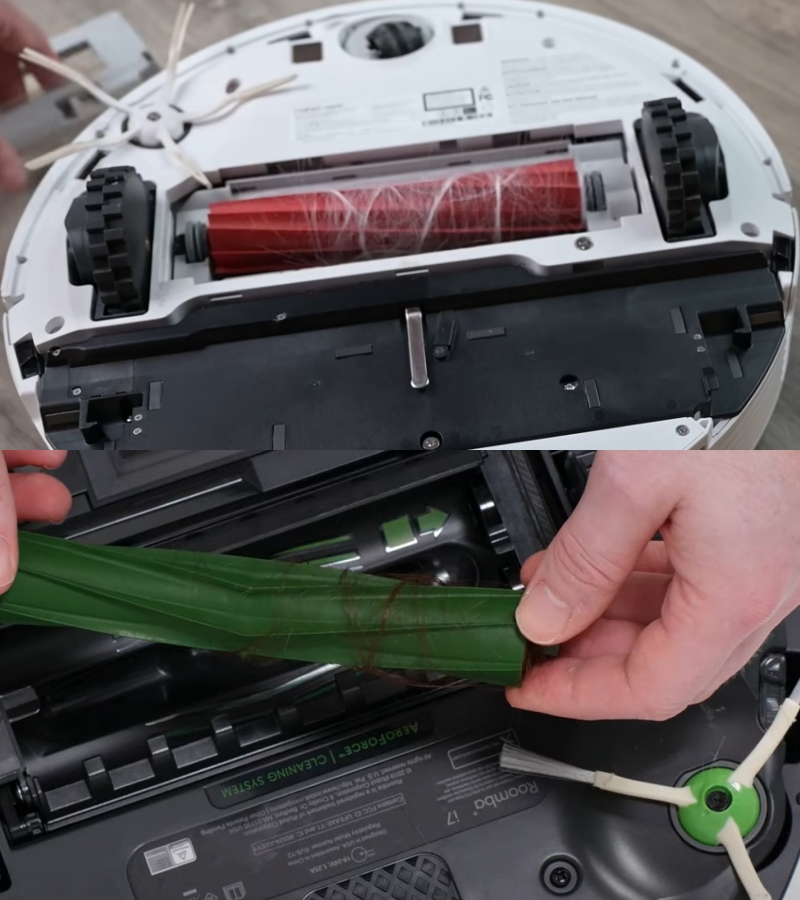
Design & Convenience
Winner: Roborock S7
Dimension
These two robot vacuums have a similar round shape and width. However, the Roborock S7 has a greater height, about 3.8 inches, owing to its top-mounted LiDAR tower. Thus, the S7 cannot go under furniture with a clearance of lower than 3.8 inches. Meanwhile, with a height of about 3.6 inches, the Roomba i7 can move under furniture with the same space clearance without getting stuck.
Thus, if you want to get a robot vacuum to clean under furniture areas (free from scattered objects like wires and cords), you should take the robot’s height into consideration. Measuring the clearance under furniture is also recommended before purchasing your own robot vac.
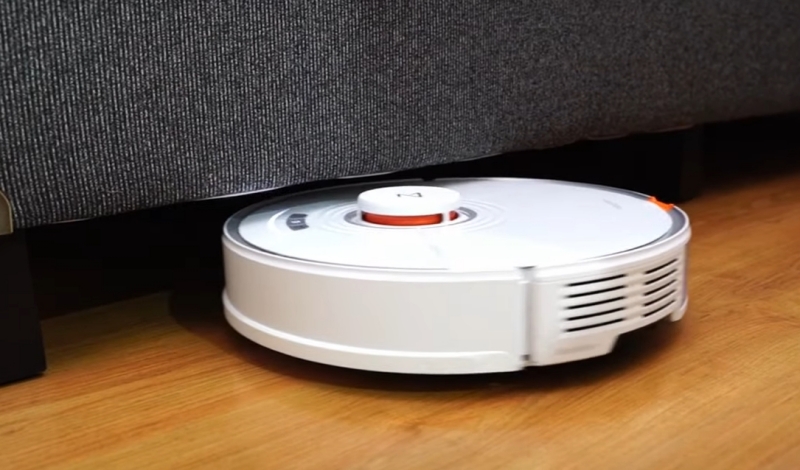
Brush roll system
The brush roll system is the feature that contributes to the good cleaning efficiency of these bots. Both the Roomba i7 and Roborock S7 upgraded their main brushes to rubber brushes instead of the bristle brushes like on the lower-tier models. The rubber brush rolls effectively enhanced the hair resistance of the bots.
However, the Roomba i7 features dual brush rolls, whereas the Roborock S7 has a single brush roll. The dual brush system will give a greater surface agitation than the single one, so the cleaning performance could be better.
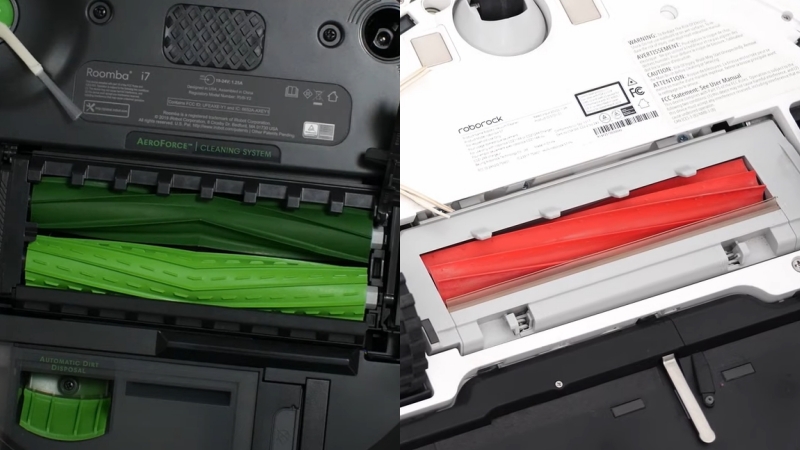
Nevertheless, the S7 shows to be the better in carpet cleaning test, which could be attributed to the upgraded brush roll housing. The brand calls it a “floating brush”, allowing the brush to stick to different flooring surfaces, providing a greater seal to enhance the pickup efficiency.
Coming to the side brushes, these two bots have one side brush with multiple prongs. The Roborock has a greater number of prongs than the Roomba i7. Specifically, the Roomba i7 side brush has 3 prongs while that of the Roborock S7 has 5 prongs. Besides, the S7’s side brush prongs are all rubber, instead of bristle prongs like on the i7, making it more durable and easy to clean.
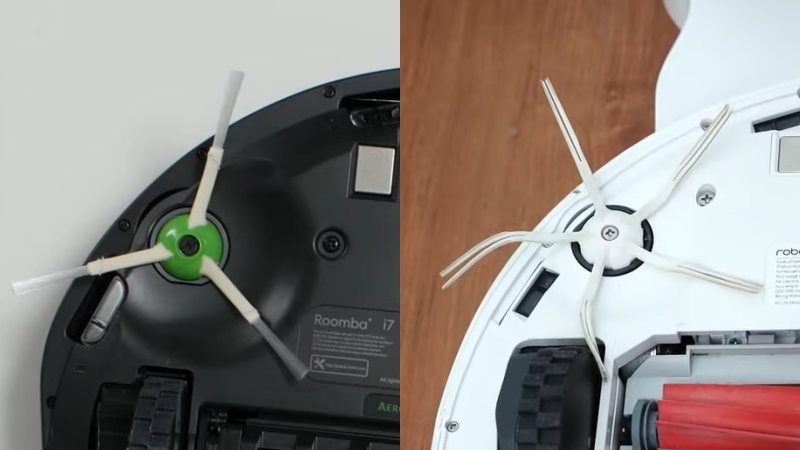
Navigation & Obstacle avoidance
- Navigation & Mapping
For the navigation, I can say that the Roborock S7 is in the top tier of the market owing to its precision LiDAR navigation technology. The laser tower on the top of the S7 can recognize objects and furniture more effectively than the vSLAM technology on the Roomba i7. In this way, the S7 can work in dim or dark environments.
The Roborock S7 maps my house very quickly, within half an hour in the first runs. It also allows me to save 4 different floor plans, meaning I can select the room and floor level I want the bot to clean. Another thing I appreciate about the Roborock S7 is its wall sensors, helping the bots to run along instead of bumping into walls.
The Roomba i7 utilizes the vSLAM navigation, using the top-mounted camera to capture the furniture and other things in my room. I found this way of mapping less effective than using LiDAR because it needs bright light to provide the best performance and takes more time and more runs to complete a floor plan.
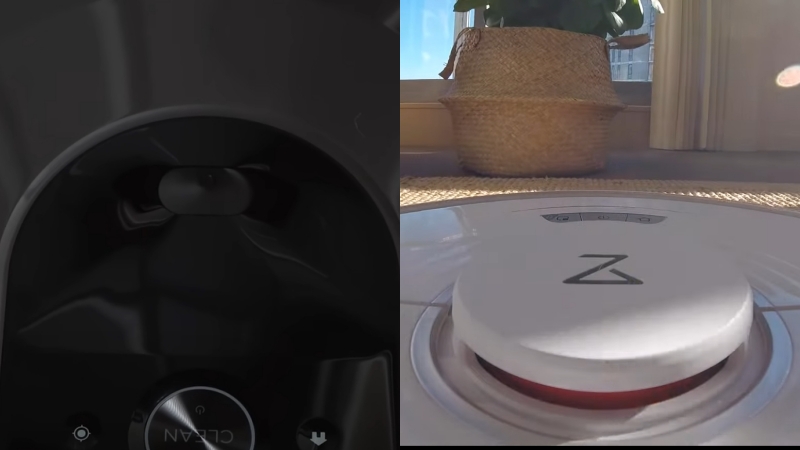
Additionally, the Roomba i7 often crashes into furniture and walls, more than the Roborock S7. One thing the Roomba i7 is better than its rival is the number of saved maps. It supports you to save up to 10 different floor plans; what an impressive number!
Furthermore, both of these appliances are equipped with advanced cliff sensors to ensure they avoid tumbling down stairs. Moreover, they execute cleaning in neatly straight patterns, giving better coverage and higher cleaning efficiency than the ones with random patterns.
Obstacle avoidance
Unfortunately, they do not have an obstacle detection function, so they fail the test of avoiding objects scattered on the floor. If the object height is lower than the scanning level of the LiDAR tower and the top camera, or too light for the bot’s bumpers to recognize, the bots will run into them.
In the test, neither the Roborock S7 nor the Roomba i7 does avoid the cords, socks, and shoes. Therefore, you need to make sure to pick up items scattered on the floor before running them. Moreover, they will not avoid pet waste. So, if you have to deal with in-house pet waste, you need to spot and clean the waste before the bots do their job.
Yet, if you find cleaning items daunting, you can opt for the Roomba J7 or J7+, as these models are outstanding in obstacle avoidance and even recognize different shapes of pet waste to avoid them effectively.
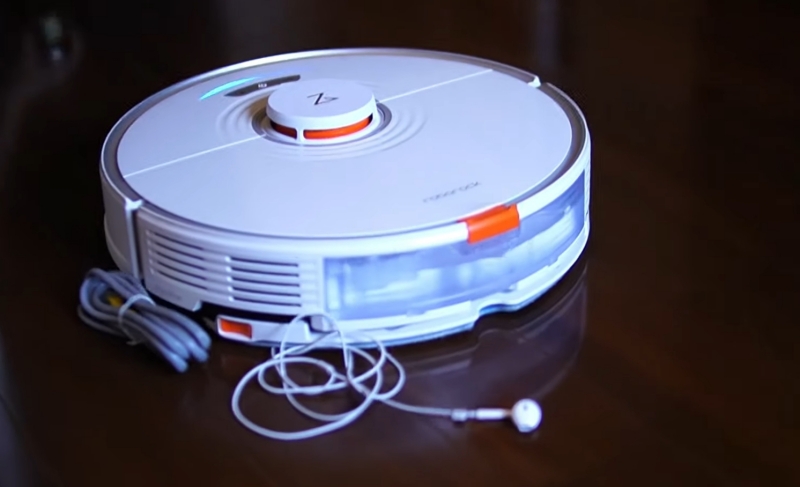
Battery life
| Roborock S7 | iRobot Roomba i7 | |
|---|---|---|
| Capacity | 5200 mAh | 1800 mAh |
| Battery life | ~ 120-180 minutes | ~ 80 minutes |
| Charging time | ~ 6 hours | ~ 2-3 hours |
The Roborock S7 features a larger battery capacity than the Roomba i7. This means the Roborock has a longer runtime than its rival, allowing about 120-180 mins of vacuuming and mopping, depending on the suction levels and mopping intensity.
Control
Winner: Roborock S7
Physical control
The button controls on the Roborock S7 are quite similar to each other. They all have a clean and power, a dock home, and a spot clean button. However, the spot clean button on the Roborock S7 has another function called “Child Lock”.
When holding down this button for 3 seconds, the Child Lock mode is activated, and all the buttons on the S7 will be disabled. Then, to escape the Child Lock mode, I just need to hold down this button again for 3 seconds. This mode can be also activated using the Roborock app.
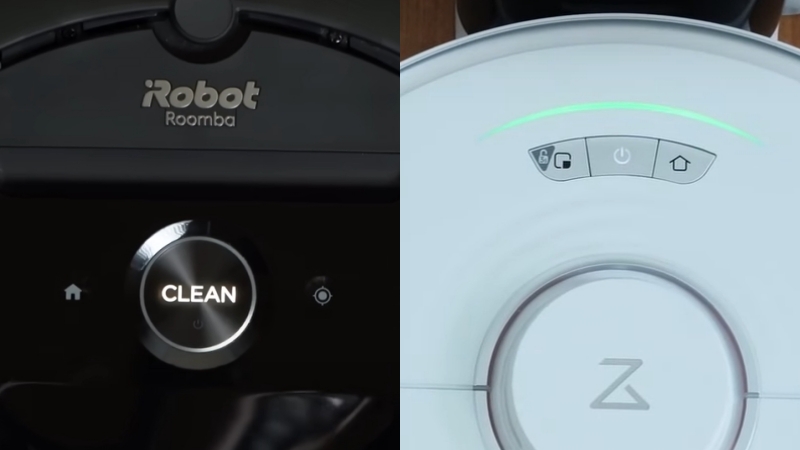
App control
Their apps are intuitive and versatile to use. Both of them can map, create, and save different floor plans for me. In the app, I can edit the map by labeling, dividing, or merging the rooms in the way I want. Additionally, I use the app to send these bots to clean selected rooms or a zone in a room, instead of cleaning the whole house using the app. Besides, if I don’t want them to enter or clean certain areas, I can set the no-go zones or keep out zones in the S7 and i7 apps.
Moreover, scheduling the cleaning for these bots is easy to do with the app. I can create different cleaning schedules for different rooms. They also provided me with a thorough cleaning history so I could know when they cleaned, how long their cleaning sessions were, and where they got stuck. Plus, if my hands are busy, I can speak to ask the S7 or i7 to clean specific rooms or spots as they are compatible with voice assistants like Alexa and Google Home.
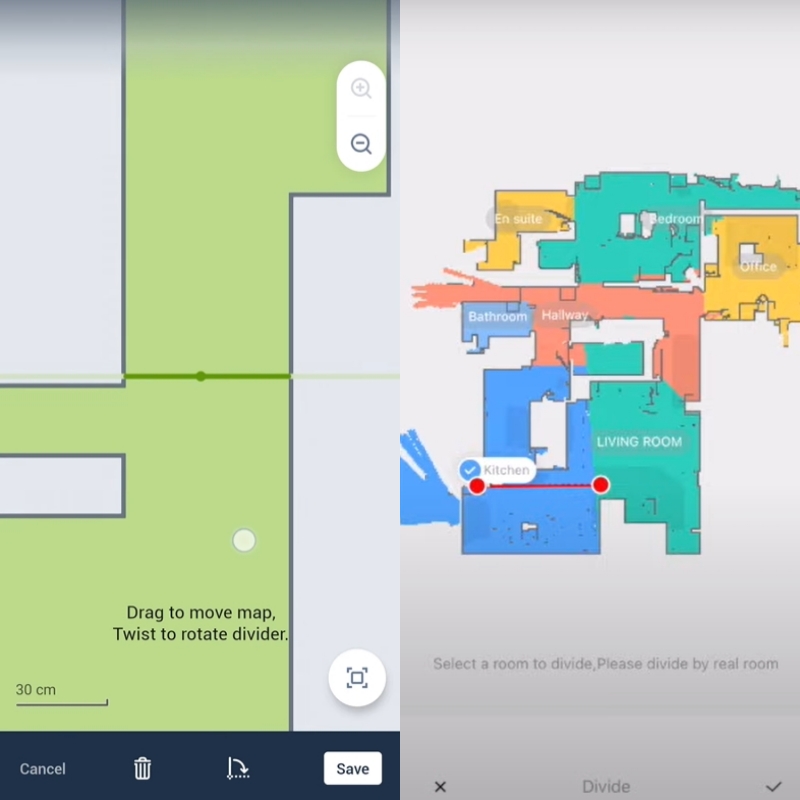
Yet, their apps show specific differences in their app features. I’ve made a list of notable differences and demonstrated as below:
| Features | Roborock S7 | Roomba i7 |
|---|---|---|
| Full-bin notification | No | Yes |
| Child Lock | Yes | No |
| Vacuum Power Adjustment | Yes | No |
| Mopping Intensity Adjustment | Yes | No |
| Invisible Wall | Yes | No |
| No-mop Zone | Yes | No |
| Customize the cleaning for each room | Yes | No |
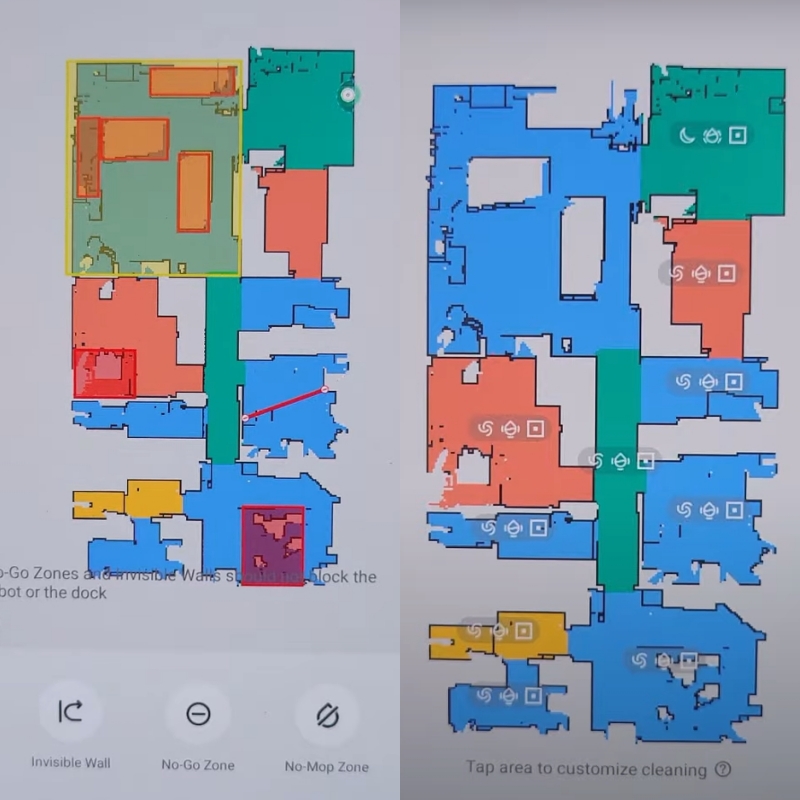
Cleaning & Maintenance
Winner: Roomba i7
The Roomba i7 features a HEPA-graded filter (high-efficiency filter) for its filtration system, which can filter up to 99% micro dust and allergic agents. Whereas the filter in the Roborock is the brand’s E11 filter type with a filtering efficiency percentage of approx. 95%.
However, the filter of Roomba i7 is not washable and needs gentle taps to remove the dust, as recommended by the brand. On the flip side, the Roborock S7’s E11 filter can be washed with tap water but not dishwasher-safe. Besides, both bots need filter replacement every 6-12 months, depending on the cleaning frequency.
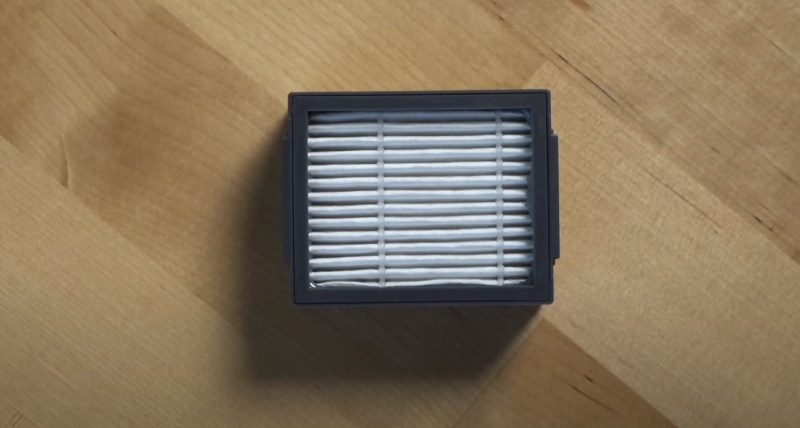
Their dustbins have a relatively large capacity, about 470-500 ml, a little bigger than the volume of other bots in the market. After dumping the dustbin, you should rinse them under warm water and let them dry for at least 24 hours before being re-attached to the bots.
Nevertheless, as the Roborock S7 has a simultaneous mopping function, it is essential to check its water tank and refill it. Moreover, the mopping clothes must be washed after every run to ensure the hygiene and performance of the robot in the next run.
One thing the Roomba i7 and Roborock S7 have in common is that they are all compatible with self-empty clean bases, using disposal dust bags for hand-free dustbin emptying. For me, getting this clean base is a life-changing choice I have ever made because my nose is now not disturbed by dust clouds anymore. So, if you have the same problem as me, the self-empty base is worth your extra spending. Still, opting for the Roborock S7+ or Roomba i7+ will be a more economical choice.
Additionally, though they can handle hair tangling fairly well, you still need to check their bottom every two weeks to remove hair strands stuck on edge brushes, roller bearings, and castor wheels. Besides, their sensors require gentle cleaning regularly to ensure optimal performance.
Other features
Winner: Roborock S7
Noise levels
| Roborock S7 | iRobot Roomba i7 | |
|---|---|---|
| Working | ~60 – 78 dB | ~46 – 60 dB |
| Self-emptying | N/A | N/A |
They are not quiet but not too loud to bear. The noise levels vary as they transition between different flooring surfaces. Besides, the S7 has 4 different cleaning modes, meaning that its noise also varies between each mode. I often use the S7 in the “Balanced” mode, and the noise when it is working is moderate and does not disturb me much.
Mopping function
The Roborock S7’s mopping and vacuuming functions work simultaneously, and I was amazed by its mopping efficiency. I have tested the Q7 Max mopping function, but the Roborock S7 goes an extra mile better with its sonic mopping technology. With this sonic technology, the S7 vibrates its mopping pad to scrub the floor, enhancing the efficiency in removing stubborn stains.
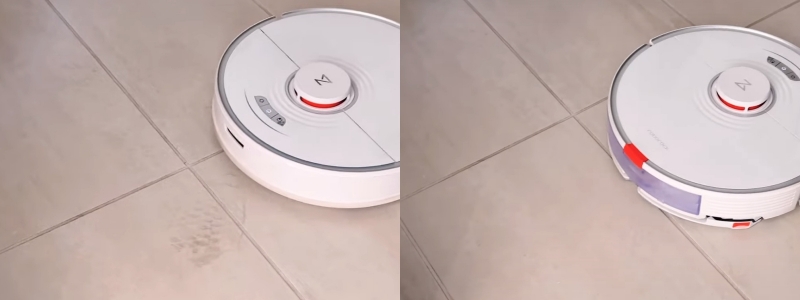
Additionally, with the equipped carpet sensor and VibraRise technology, the Roborock S7 also detects carpet areas and automatically lifts the mop for only vacuuming mode when it climbs on carpets. However, the mop is just lifted for 5mm, meaning it works best for very low-pile carpets or rugs. Fortunately, the S7’s app offers the option to set the no mop zones, which is handy when your house has medium-pile, high-pile, or shaggy carpets.
On the other hand, the Roomba i7 does not have the mopping function, but it can connect with the Braava Jet M6 robot mop via the Imprint link technology. When these two iRobot bots are connected, the Jet M6 will start mopping the floor right after the Roomba i7 returns to the dock. This means the vacuuming and mopping will be operated consecutively.
I haven’t tested the mopping performance of the Braava Jet M6, so I can’t give the best comparison of their performance. According to a thousand reviews on Amazon, the Jet M6 does a good job at mopping, even the best in its price range for a robot mop. Meanwhile, in the market of vacuum-mop robots at the same price tags, the Roborock S7 stands out at the top tier.
Virtual Wall Barrier
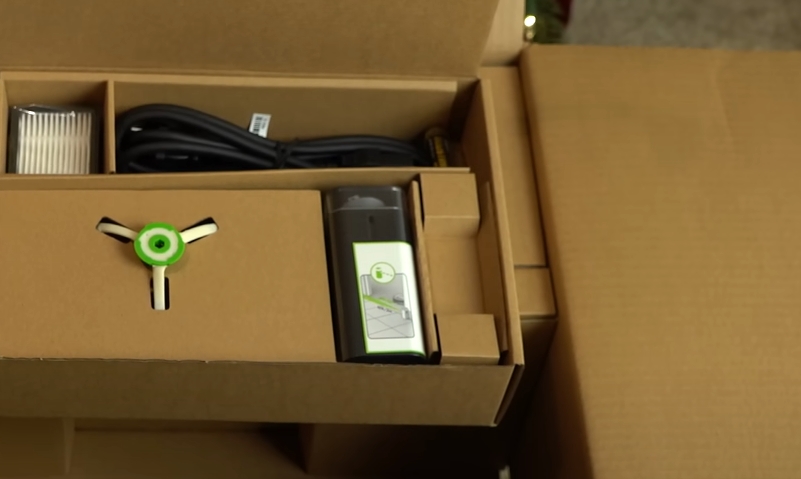
The Roomba i7 comes with a Virtual Wall Barrier in the box. This dual-mode virtual wall serves as a versatile tool for establishing a protective barrier in both circular and linear configurations. Its primary purpose is to safeguard designated areas by deterring bots from entering restricted spots, similar to the Invisible Wall function in the Roborock app.
Quick Rundown of Roborock S7
- Sonic Mopping Technology. Roborock S7 robot vacuum mops with the power of sound, scrubbing up to 3,000 times per minute. Fed by a 300 ml electronic water tank, stains from coffee to mud and more can be cleaned deeply and effectively.
- Intelligent Mop Lifting. S7’s VibraRise mop lifts when a carpet is detected, so you can mop hard floors and vacuum carpets in a single clean. It also raises when cleaning is finished to avoid spreading dirt, and when docked so you can say goodbye to ugly plastic mats and dirty streaks.
- Upgraded Brush System. Multi-directional floating brush keeps the brush closer to the ground for deeper cleaning even on uneven surfaces. Roborock S7’s all-new rubber brush is more durable and resists hair tangling better. It’s perfect for homes with pets.
- Powerful Performance. With 580g mop pressure and 2500PA HyperForce suction, Roborock S7 easily lifts dust and hair from floors and pulls it from deep inside carpets. It is the most powerful and the most convenient robot vacuum Roborock has ever made.
- Ultrasonic Carpet Recognition. Roborock S7 accurately identifies carpets using ultrasonic sound. Once a carpet is recognized, S7 will automictically boost the suction power for a deeper carpet cleaning. You can also choose to have the mop lift to vacuum low-pile carpets, or use No-Mop Zones to prevent it from cleaning medium and high-pile ones. You do not need to worry about wet carpets while cleaning the floor.
Quick Rundown of iRobot Roomba i7
- POWERFUL PERFORMANCE AND POWERFUL PICK-UP - Pulls in stubborn dirt and messes with a Premium 3-Stage Cleaning System and 10X the Power-Lifting Suction. (Compared to the Roomba 600 series cleaning system)
- GUIDED BY SERIOUS SMARTS - With vSLAM navigation, the i7 learns the layout of your home and builds personal Smart Maps, enabling it to expertly clean and navigate in neat, efficient rows.
- VACUUMS MESSES IN THE MOMENT - Cleaning crumbs is now as easy as “Roomba, clean under the kitchen table.” A simple request to your voice assistant or via the iRobot Home app enables the i7 to clean messes for you, right when they happen.
- COMPLETE CONTROL OF YOUR CLEAN - With Smart Mapping, your robot knows your kitchen from your living room, so you can decide where it cleans and when. With Keep Out Zones, your robot knows to avoid sensitive areas like pet bowls or play areas.
- A CLEAN UNIQUE TO YOU - The Roomba i7 robot vacuum is smarter than ever, learning where and when you normally clean and suggesting personalized schedules so you can focus on everything else.
Product Videos
Related Articles to Roborock S7
- Roborock Q7 Max Vs S7: What Are the Differences Between Them?
- Roborock Q5 Vs S7: Both Have Excellent Performance But… Are Upgrades Worth?
- Roborock Q Revo vs S7: Battle of the Cleaning Titans!
- Comparing The Roborock S7 Vs iRobot S9: Which Prevails?
- Roborock S7 Vs Roomba S9+: An Honest Review And Detailed Comparison
- Roomba J7+ Vs Roborock S7: An Ultimate Guide
Related Articles to Roomba I7
- Roomba i4 vs i7: Choosing The Ideal Robot Vacuum For Your Home
- Roomba i3 vs i7: Which Robot Vacuum Is Right For You?
- iRobot I7 Vs S9: Which High-End iRobot Roomba is Better?
References:
- Roborock S7: https://us.roborock.com/pages/roborock-s7
- iRobot Roomba i7: https://www.shopirobot.com.au/i7.html

Richard B. Schmidt is a prominent figure in the vacuum cleaner industry, boasting over 15 years of expertise. Armed with a Robotics Engineering degree from Northeastern University and a Master’s in Consumer Science from Harvard, his unique blend of technical knowledge and consumer insights positions him as a sought-after authority in vacuum cleaner evaluation. Richard’s career began at Dyson, where he contributed to the development of innovative vacuum models. Transitioning to advocacy and reviews, he co-founded the first Vacuum-focused blog in 2008, offering comprehensive analysis and user guides for various vacuum cleaners. In 2020, he founded RoboMop.net, providing ongoing insights through columns and buyer’s guides.
